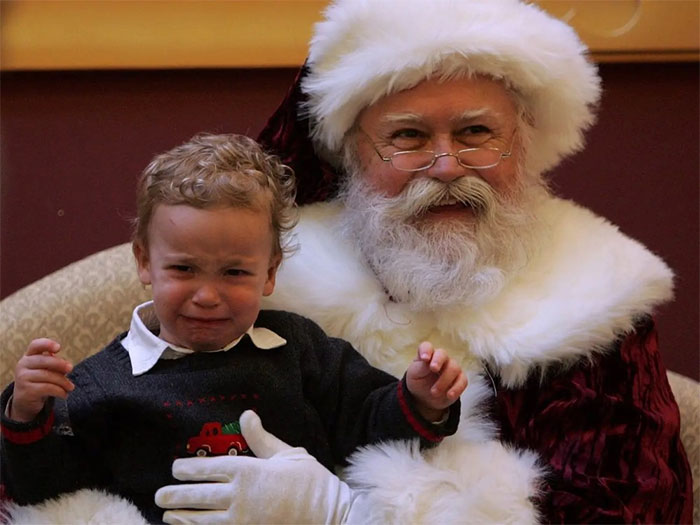Science explains why children still believe in Santa Claus
Christmas is coming again, bringing with it many mysterious stories, the famous Santa or Santa Claus story is no exception.
Children are always told of an immortal man who lives in the far north, knows everything they want, sits on a sled pulled by flying reindeer, and he 'suddenly' 'enter the house through the chimney, despite the fact that not many houses have chimney today.

Studies show that up to 83% of 5-year-old children still believe that 'Santa Claus' is real.Why?(Image: Justin Sullivan / Getty Image).
Although there are many contradictions or even absurdities in this story, the surprising thing is that the kids still believe this is true. There have been studies showing that up to 83% of children at the age of 5 still believe in Santa. Why is that?
It is an advantage to develop
The root of this paradox lies in the nature of the child , who is easy to believe in everything they hear rather than a rational one. By Richard Dawkins, a researcher on behavioral and evolutionary biology, in a 1995 essay, children are easy to believe and almost believe in everything, but it is actually a developmental advantage.

Young children actually receive and analyze the information they have in a very reasonable way.They have a unique but similar way to adults to decide what to believe and not to believe in.(Image: Andrew Burton / Getty Images).
Dawkins convincingly describes by taking the example of children living near a crocodile-covered swamp. He explained, that children who are skeptical and tend to consider their parents ' advice not to swim in the swamp , will have less chance of survival than children who have no questions about adult advice.
Children who easily trust people are not a new thing. In the same way, 18th-century philosopher and psychologist Thomas Reid shared that young children have a strong belief and belief in everything that people around them tell them.
But this is not much different from adults
However, they do not just listen to and trust immediately. Recent studies have shown that young children are actually receiving and analyzing the information they have in a very reasonable way. In fact, children have a unique but similar way to adults to decide what to believe and not to believe in.
So what are some of the ways that adults should decide what they should trust, as well as any evidence that the children are the same?

One of the ways adults learn about something new is to listen from another person.Children also learn new knowledge in the same way.(Photo: US Marines, taken by Sgt. Aaron Hostutler).
We will focus on the following three things:
- The first is paying attention to the context of receiving information.
- This is followed by a review of new information received, based on existing knowledge.
- The final is based on expert judgment.
Let's start with the context in which we gain new knowledge.
Imagine that you are reading a newspaper that gives information about a new species of fish - let's just call them 'spooky fish', then continue to imagine you reading that piece in different contexts. The first scenario is when you are in the waiting room, waiting to turn to see the doctor, you read that piece from a famous journal in the scientific world.
In another context, while queuing in front of the grocery store and poring over a newspaper specializing in commercial trade, you come across a piece of this new discovery. I am sure the surroundings will affect your assessment of the authenticity of the new fish.
'We did the same test on children. We told the children about a new and unknown animal they had never known before, such as 'liar'.
A group of children heard the news amidst mysterious elements, for example, the night before they had heard of dragons and demons that would kidnap children if they broke down. "The group of the rest of the children are aware of this 'spooky fish' in the same context as the lessons at school, as well as this fish is interested by scientists and veterinarians."
Children aged 4 to 5 will immediately assert that 'fake fish' really exists when they have just been heard in the context of school, the opposite result occurs with the remaining group of children.
Self-assessment and hear from experts
One of the basic ways that we adults learn about something new is to listen from another person. Imagine that you heard about this new species from a marine biologist, instead of hearing from a neighbor near you who often spread rumors of alien creatures abducting humans.
Authentic analysis from experts or reliable sources makes you confident and quickly draw conclusions about the existence of this fish.

Parents and those around them are said to be responsible for keeping the 'Santa Claus' story alive.In a recent study, 84% of parents took their children to meet at least 2 Santa's stuntmen at Christmas.(Image: Joe Raedle / Getty Images).
In another research project, we introduced the kids to incredible animals, such as the fish that live in the ocean, from sounds that seem normal to unbelievably big. cars, or even myths like fish living on the moon.
And we let the kids find the truth on their own, no matter whether they meet the creature or ask someone. They are also heard comments from the zookeeper in the zoo (expert) or from a cook (not an expert).
We discovered that children will believe in real things and reject myths. Children make decisions by comparing information with what is known.
For unbelievable animals (such as a fish as big as a car) - which may exist but are rare or strange, children will choose to trust the zoo keeper rather than the cook. In other words, children want to hear from experts, similar to our adults.
The children are gradually maturing
If children are so smart, why do they still believe in the story of 'the snowman'?
The reason is quite simple: Their parents and the people around them have done everything to make the children believe in the magical Santa story. In a recent survey, nearly 84% of parents took their children to meet at least 2 people pretending to be Santa Claus in the Christmas season to confirm that he is real.
`` The Elf on the Shelf '' is a comic book for young children about the dwarfs, tasked with monitoring and informing Santa about the good situation of the children in the Christmas season, which has now become A brand worth millions of dollars. Not only that, the US Postal Service even runs the 'Letter from Santa' event , providing a personalized response service for each child who sends a letter to Santa.

Believe in Santa, the fact that children are practicing self-development, scientific reasoning.(Image: Andrew Burton / Getty Images).
Why do adults have to take such fun lies so far? Why are parents trying to climb to the roof on Christmas Eve, pretending to be the heavy sound of a snowman walking, and ringing a Christmas bell?
The answer is actually quite simple: Children are not light-hearted and gullible in everything we say. So we adults have to create real, lots of evidence, from bells on the roof, Santa with bones in the malls, or even junk food from 'someone' who survived the next morning - 'he must be very hungry to deliver countless presents on a cold night'.
How do the kids practice analysis?
With the above mentioned preparation, it is hard for children not to believe in the snowman. In fact, believing in Santa Claus is the way children practice their scientific reasoning ability.
First, the children assess the source of information. One study found that children tended to trust adults more than their peers.
Next, the children used a lot of evidence (such as a glass of empty milk or a cracker after Christmas Eve) to draw realistic conclusions. Other author studies have also shown that children also use evidence to evaluate the fictional character 'Sweet Candy Witch', arrive at night to take away candy, and leave behind many interesting toys.
Finally, research also shows that the more deeply a child thinks, the more often they realize the irrational points in the mystical story. How can a big man get into a narrow chimney like that? Or how can reindeer fly without wings?
Will children stop believing in adults?
Many worried parents continue to tell paranormal stories about 'Santa' that can harm their children's trust in their parents. Many philosophers and bloggers have similar thoughts and controversy over this 'traditional lie', some even arguing that in the long run it may prevent children from hearing his father's words. mom too.
So what do we do as parents?
There is no scientific evidence of concern about harming children when they find out that Santa Claus is only a fictional character created by their parents. Moreover, children not only have the ability to find out the truth, but the story of the snowman also gives them an opportunity to sharpen this skill.
So, if you think inviting a Santa Claus impersonator to your home can make the family happier and more cozy at Christmas, go ahead. The children will be fine. And then, they may learn something new.
- You are unknowingly harming children by making them believe that Santa is real
- The prototype of Santa Claus - The fairy of young children around the world
- Discover the 'super car' of Santa's models
- Santa is under the eyes of the physicist
- Why does Santa wear red clothes again?
- The bone fragment of Santa's prototype
- Stunned with Santa's 'terrible' workload
- Where is Santa's office?
- Santa Claus under the eyes of science
- Discovering the grave of the prototype of Santa Claus
- What does Santa need to overcome to get Christmas gifts?
- You are accidentally harming children when they make them believe that Santa is real
- Mysterious Christmas demon Krampus - Cruel version of Santa Claus
 'Fine laughs' - Scary and painful torture in ancient times
'Fine laughs' - Scary and painful torture in ancient times The sequence of numbers 142857 of the Egyptian pyramids is known as the strangest number in the world - Why?
The sequence of numbers 142857 of the Egyptian pyramids is known as the strangest number in the world - Why? History of the iron
History of the iron What is alum?
What is alum?